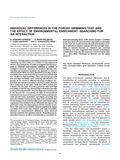Mostrar el registro sencillo del ítem
Individual Differences In The Forced Swimming Test And The Effect Of Environmental Enrichment: Searching For An Interaction
| dc.creator | Sequeira Cordero, Andrey | |
| dc.creator | Mora Gallegos, Andrea | |
| dc.creator | Cuenca Berger, Patricia | |
| dc.creator | Fornaguera Trías, Jaime | |
| dc.date.accessioned | 2014-12-15T20:28:34Z | |
| dc.date.available | 2014-12-15T20:28:34Z | |
| dc.date.issued | 2014-02-05 | |
| dc.identifier.citation | http://www.sciencedirect.com/science/article/pii/S0306452214000682 | |
| dc.identifier.issn | 0306-4522 | |
| dc.identifier.other | essn:1873-7544 | |
| dc.identifier.uri | https://hdl.handle.net/10669/11227 | |
| dc.description | artículo -- Universidad de Costa Rica, Centro de Investigación en Neurociencias e Instituto de Investigaciones en Salud. 2014. Este documento es privado debido a limitaciones de derechos de autor. | es_ES |
| dc.description.abstract | Animals with low and high immobility in the forced swimming test (FST) differ in a number of neurobehavioral factors. A growing body of evidence suggests that the exposure to enriched environments mediates a number of changes in the brain. Therefore, we studied if animals’ individuality can somehow modulate the response to environmental stimuli. Male rats were classified according to their immobility time scores in theFSTtest session as animals with low, medium or high immobility. Then, rats from groups with low and high immobility were randomly distributed in two groups to be reared in different housing conditions (i.e., enriched and standard conditions) during 8 weeks. Animals were subjected to the open field test (OFT) before and 6 weeks after the start of housing protocol. Rats with high immobility in the FST also showed high ambulation and high rearing time in the first OFT. Such findings were not observed in the second OFT. Conversely, an effect of environmental enrichment was found in the second OFT where enriched animals showed lower ambulation and higher grooming time than the standard control group. Rats were sacrificed after the housing protocol and neurochemical content and/or gene expression were studied in three different brain regions: the prefrontal cortex, the hippocampus and the nucleus accumbens. Rats with low immobility showed significantly higher accumbal 5-HT levels than animals with high immobility, whereas no neurochemical differences were observed between enriched and standard animals. Regarding expression data, however, an effect of enrichment on accumbal corticotropin-releasing factor (CRF) and its receptor 1 (CRFR1) levels was observed, and such effect depended on immobility levels. Thus, our results not only allowed us to identify a number of differences between animals with low and high immobility or animals housed in standard and enriched conditions, but also suggested that animals’ individuality modulated in some way the response to environmental stimuli. | es_ES |
| dc.description.sponsorship | Universidad de Costa Rica. | es_ES |
| dc.language.iso | en_US | es_ES |
| dc.publisher | Neuroscience 265(1):95-107 | es_ES |
| dc.subject | environmental enrichment | es_ES |
| dc.subject | neurotransmitters | es_ES |
| dc.subject | gene expression | es_ES |
| dc.subject | nucleus accumbens | es_ES |
| dc.title | Individual Differences In The Forced Swimming Test And The Effect Of Environmental Enrichment: Searching For An Interaction | es_ES |
| dc.type | artículo original | |
| dc.identifier.doi | http://dx.doi.org/10.1016/j.neuroscience.2014.01.047 | |
| dc.description.procedence | UCR::Vicerrectoría de Investigación::Unidades de Investigación::Ciencias de la Salud::Instituto de Investigaciones en Salud (INISA) | es_ES |
| dc.description.procedence | UCR::Vicerrectoría de Investigación::Unidades de Investigación::Ciencias de la Salud::Centro de Investigación en Neurociencias (CIN) |


